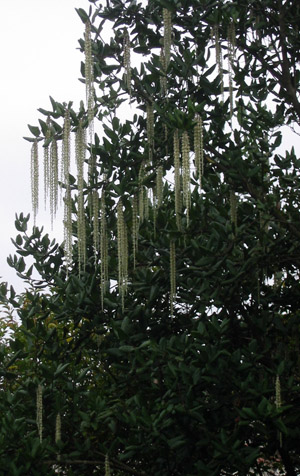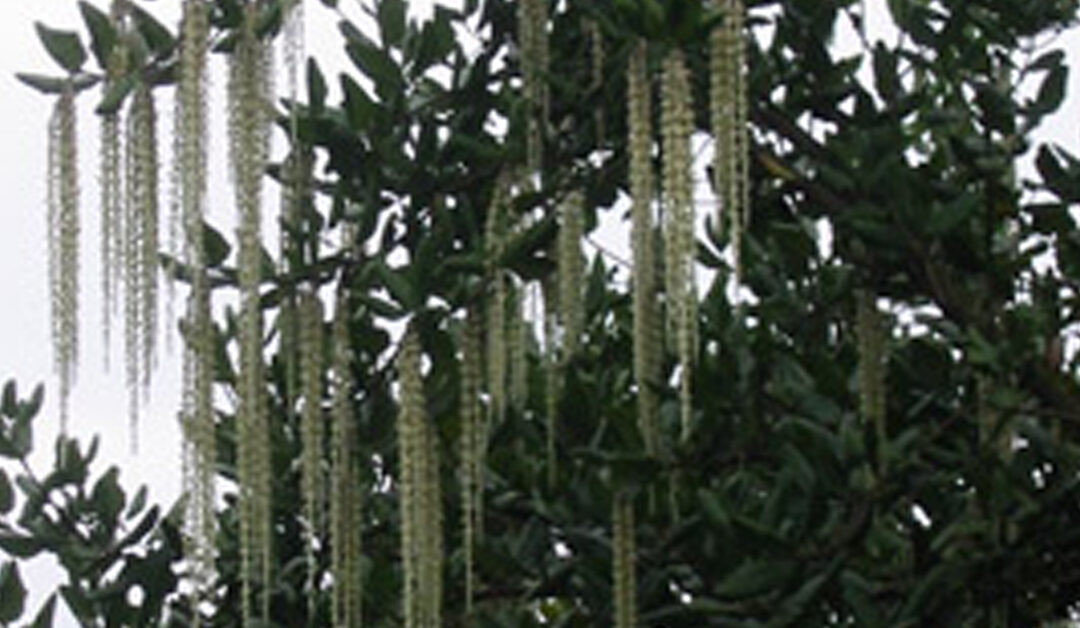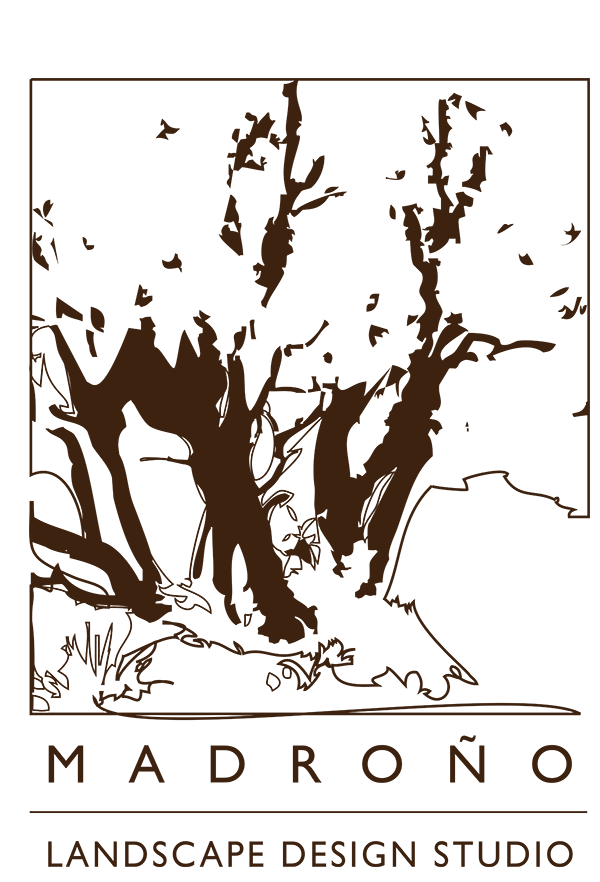Leave your car in the parking lot on Skyline Blvd. in the Oakland Hills and step through the unknown, remembered gate onto the huckleberry path. Inhale the aroma of rain on the wind, a perfume mixed with the bouquet of a mature bay forest. Sheer rocky knolls punctuate the canyon, its story a potboiler of earthquakes and eruptions. Mist drapes maverick oaks and madrones in fleeting gossamer gowns, and paints the tops of trees on the ridge across the valley. The voice of the river rises from below, a music older than memory.
You have just entered the Huckleberry Botanic Regional Preserve, a living time capsule. For the next few hours, try to fit your calendar and your clock into the big picture. Forget about your spouse’s birthday next week, your kid’s piano recital next month, and that quest for a promotion next year. Quit wondering what to nickname the current decade, and get over the gravitas of the 21st century. Millennia are still too small — stop looking at the whale through a microscope. Take a moment and adjust your units.
The geology here is shale and radiolarian chert, the petrified shells of microscopic sea creatures who lived half a trillion years ago. By comparison, this formation’s existence as a mountain ridge is still a puppy, upthrust from the ocean floor a mere 12 million years ago. Much of the present native plant community has grown here for 5 million years in a relict association found nowhere else in the East Bay, but only in areas along the California coast like the Channel Islands, Point Conception, and Montara Mountain.
At the trailhead for the huckleberry path, a wooden bin holds informational fliers and a printed key for a self-guided tour, where17 numbered stations along the trail identify plants and communities described in the key. To watch history evolve in the proper direction, follow the self-guided tour backwards: take a right where the sign for the Huckleberry Path points left, and walk the trail counter-clockwise.
The character of this flora is marked by succession, that natural sequence of changes by which certain groups of plants are replaced by others. The laws are dictated by the chert, a harsh and nutrient-poor soil that limits the varieties of plants that can live here; yet succor arrives with moisture blowing in from the Golden Gate, sustaining any species that take hold. Hot summers and frequent wildfires write an agenda driven by flame.
In the first stage of succession after a fire, manzanita (genus Arctostaphylos) dominates the field. The trail between stations 17-10 passes through large communities of A. crustacea, a mid-size shrub, and the rare and endangered A. pallida, a small (between 6-16 feet) highly architectural tree that occurs only here in the northern Diablo range. These hardy colonizers of the chaparral thrive in bleak edaphic conditions, and reproduce through fire: A. pallida seeds will germinate most readily in charred landscapes, while A. crustacea grows a thick fire-resistant burl at its base that sprouts with vigor after a burn. The “manzanita barrens” at stations 10 and 6 show the elfin-forest quality of these communities at an early stage, before the arrival of competitors — and right now they’re in magnificent bloom, lasting through March.
Over time, birds introduce new plants via their droppings, which contain the seeds of berries they’ve eaten in neighboring regions. Now mixed with the manzanita are huckleberry (Vaccinium ovatum), minor giant chinquapin (Chrysolepsis chrysophylla var. minor), and coast silk tassel (Garrya elliptica), the harbingers of the middle stage of succession. Huckleberry is the dominant shrub here, a fast-growing evergreen that produces delicious edible berries in the fall. Chinquapin has boat-shaped leaves with a gold fuzz on the underside (its name is Greek for “golden scale”) and summer fruit encased in nutlets that birds adore.

Garrya, easily confused with a 10- to 25-foot oak tree during spring, summer and fall, becomes unmistakable every new year. Come January, the trees send out numerous 7- to 12-inch catkins — hundreds of them dangle from above in a tinsel effect, with each white flower cluster like the delicate fringe on a graduate’s cap. Garrya has separate male and female trees: the females reach only 10-15 feet tall and grow shorter, less-attractive catkins, while the males are taller with the long, showy blooms prized by horticulture. Interested gardeners should ask about choice cultivars like ‘James Roof’ and ‘Eve.’
These “second generation” plants eventually form a tall, dense canopy that shades out and kills the manzanita. In turn, the larger-growing chinquapin will some day overwhelm and kill the huckleberry. Leaf duff accumulates over the ages, rendering the soil more organic and fertile, opening the door for a wider and larger variety of plants to compete. Seeds arrive on the wind, or with animals. The slow hand of time flips the calendar, 10,000 years per page.
Halfway along our reverse-journey on the huckleberry path, the trail curves back on itself and veers downhill into bay forest, the ultimate stage of succession. The deepening shadows swallow the day, and the river’s murmur grows more clear. Canyon live oak (Quercus chrysolepsis) and madrone (Arbutus menziesii) reach up between the 75-foot California bay trees (Umbellularia californica), a canopy that shades out most competitors in the hushed, fragrant understory.
Bays often grow in multiple trunks curving outward from the center, like the stems of a giant nosegay. As each trunk grows longer and heavier, its own weight bows it back toward the earth, often until it exceeds the angle of repose, and collapses; the lateral branches will die on the bottom and sides of the now-horizontal limb, but the upward-pointing branches will continue to grow, capable in time of reaching the height and girth of the original tree.
Where does it all lead? Looking at the base of these plants growing here, where stem becomes root, provides a clue. The manzanita, chinquapin, Garrya, madrone, oak, and bay all form basal burls, thickened knots of wood at the surface of the soil, the better to regenerate through fire. If a blaze torches the deadwood and old growth, the burl will sprout prolific healthy new shoots, regenerating the community. Huckleberry crown-sprouts after a burn, the analogous adaptation. Exposed sites and decrepit populations may be devastated completely by a fire, setting the stage for manzanita. We find the last of earth left to discover is that which was the beginning, where the tongues of flame are folded into the crowned hitch of fire, and the fire and the bloom are one.
* * *
Madroño founder Geoffrey Coffey writes for the garden section of the San Francisco Chronicle. He sends his apologies to T.S. Eliot.

Madroño president Geoffrey Coffey started the company in 2005 out of the back of a pickup truck. His garden column, “Locals Only”, first appeared in the San Francisco Chronicle in 2002. He lives in San Francisco with his wife and two children, where he also sings and thumps the bass for Rare Device.


